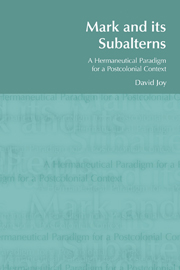Book contents
- Frontmatter
- Contents
- Foreword
- Acknowledgements
- 1 General Introduction
- PART I Hermeneutics: General Methodological Considerations
- PART II Mark – Context and Interpretation
- 4 Colonial Powers and their Marks in Mark
- 5 Mark and its Subalterns: A Product of Conflict and Resistance?
- 6 Mark 10:17–31 in the Light of the Issues of the Poor and their Representation: A Postcolonial Reading
- 7 Mark 7:24–30 in the Light of Race, Gender and Hybridity: A Postcolonial Reading
- 8 Mark 5:1–20 in the Light of the Issues of Class, Nationalism and Subalternity: A Postcolonial Biblical Reading
- 9 General Conclusions: Hermeneutical Issues and Concluding Summary
- Endnotes
- References
8 - Mark 5:1–20 in the Light of the Issues of Class, Nationalism and Subalternity: A Postcolonial Biblical Reading
from PART II - Mark – Context and Interpretation
- Frontmatter
- Contents
- Foreword
- Acknowledgements
- 1 General Introduction
- PART I Hermeneutics: General Methodological Considerations
- PART II Mark – Context and Interpretation
- 4 Colonial Powers and their Marks in Mark
- 5 Mark and its Subalterns: A Product of Conflict and Resistance?
- 6 Mark 10:17–31 in the Light of the Issues of the Poor and their Representation: A Postcolonial Reading
- 7 Mark 7:24–30 in the Light of Race, Gender and Hybridity: A Postcolonial Reading
- 8 Mark 5:1–20 in the Light of the Issues of Class, Nationalism and Subalternity: A Postcolonial Biblical Reading
- 9 General Conclusions: Hermeneutical Issues and Concluding Summary
- Endnotes
- References
Summary
Introduction
In the light of the findings of the previous two chapters, it is appropriate to search for the subaltern voices in this author's context as these offer a fitting response to the ongoing struggles of praxis and hermeneutics. By placing Mark 5:1–20 (the story of the Gerasene demoniac) in the context of a postcolonial situation, the present condition of the people of the margins may be deconstructed. The emergence of subaltern theology in the postcolonial era has been a significant form of resistance on the part of the subalterns. Thus some important insights from such deliberations will be used in this re-reading of the text.
It is hoped that these deliberations will assist this study in formulating a framework for a postcolonial hermeneutics. And such an attempt might expose the interplay between class, caste, nationalism, purity concerns and colonialism. These phrases and terms will be defined in the first section in order to prepare for a postcolonial reading. The discussion on the insights of traditional and Indian commentators will perhaps expose limitations in their work, in terms of understanding the possible potential of the text for liberating the subalterns of our time. Finally, there will be a detailed analysis of Mark 5:1–20, the episode of the Gerasene demoniac, in the light of the issues of class, nationalism and subalternity.
- Type
- Chapter
- Information
- Mark and its SubalternsA Hermeneutical Paradigm for a Postcolonial Context, pp. 166 - 178Publisher: Acumen PublishingPrint publication year: 2008

